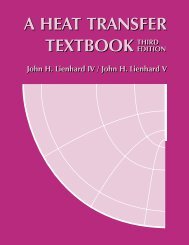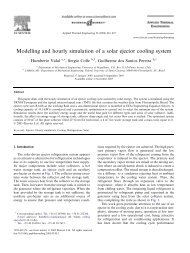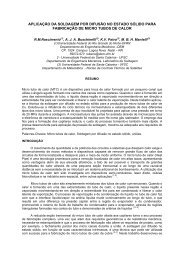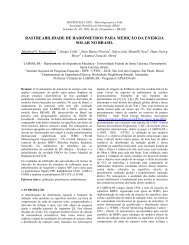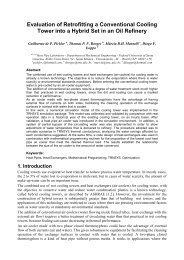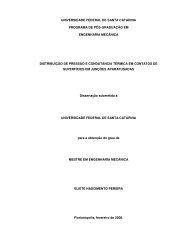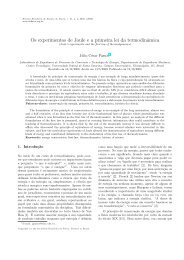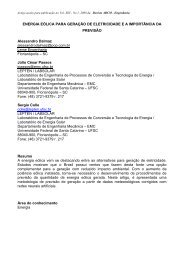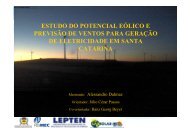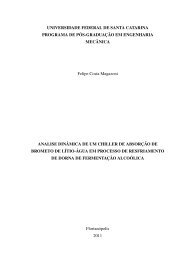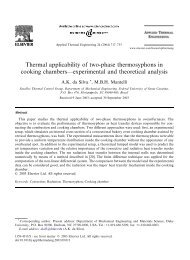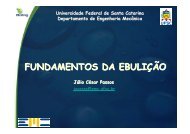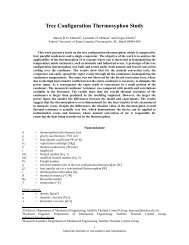Solar energy scenarios in Brazil, Part one: Resource ... - LEPTEN
Solar energy scenarios in Brazil, Part one: Resource ... - LEPTEN
Solar energy scenarios in Brazil, Part one: Resource ... - LEPTEN
You also want an ePaper? Increase the reach of your titles
YUMPU automatically turns print PDFs into web optimized ePapers that Google loves.
ARTICLE IN PRESSF.R. Mart<strong>in</strong>s et al. / Energy Policy 36 (2008) 2843–2854 2853w<strong>in</strong>ter). One hypothesis may be the <strong>in</strong>crease of aerosol particlenumber concentrations emitted to the atmosphere by the burn<strong>in</strong>gof biomass typical dur<strong>in</strong>g this time of the year <strong>in</strong> these regions.3.3. <strong>Solar</strong> irradiation over a tilted planFig. 7 presents the maps for annual and seasonal means ofglobal solar irradiation over a plan tilted to an angle equal to thecell latitude. The assessment of the ‘‘tilted’’ comp<strong>one</strong>nt is veryimportant <strong>in</strong>formation for the development of PV applications andsolar heat<strong>in</strong>g systems. Disregard<strong>in</strong>g the local topography, the solarirradiation over a surface tilted to a latitude angle is theconfiguration that allows captur<strong>in</strong>g the maximum solar <strong>energy</strong>throughout 1 year.All maps <strong>in</strong> Fig. 7 present similar patterns as discussed forglobal solar irradiation. The furthermost levels of irradiation onthe tilted plane occur <strong>in</strong> the range that goes from the Northeast tothe Southwest dur<strong>in</strong>g the spr<strong>in</strong>g and the smallest values <strong>in</strong> all<strong>Brazil</strong>ian regions occur dur<strong>in</strong>g the w<strong>in</strong>ter months.3.4. Diffuse solar irradiationFig. 8 exhibits the maps for annual and seasonal averages of thedaily total of diffuse solar irradiation. On the annual average <strong>one</strong>can observe that the Northern region receives greater diffuseirradiation ma<strong>in</strong>ly <strong>in</strong> the estuary of the Amazon River. This is dueto the larger nebulosity <strong>in</strong> the region as a result of the ITCZ<strong>in</strong>fluence. Seasonally the greatest diffuse irradiation occurs dur<strong>in</strong>gthe summer throughout the Amazon region. The smallest valueshappen dur<strong>in</strong>g the dry season (fall and w<strong>in</strong>ter) <strong>in</strong> the Southeasternand Southern regions.4. ConclusionsThis paper describes the satellite-derived assessment of solar<strong>energy</strong> resource prepared dur<strong>in</strong>g the SWERA project. The projectSWERA had f<strong>in</strong>ancial support from UNEP and GEF and it aimed atprovid<strong>in</strong>g reliable and high-quality <strong>in</strong>formation to decisionmakers, politicians, <strong>in</strong>vestors and stakeholders <strong>in</strong> order to fosterclean <strong>energy</strong> applications <strong>in</strong> develop<strong>in</strong>g countries. The solarirradiation maps for <strong>Brazil</strong> were prepared by us<strong>in</strong>g a radiativetransfer model BRASIL-SR fed by climate data and satellitederivedcloud cover data. The reliability of solar resourceestimates and model BRASIL-SR performance were checked outthrough comparisons with solar estimates provided by numericalmodels adopted <strong>in</strong> SWERA to map solar resources <strong>in</strong> otherparticipat<strong>in</strong>g countries and comparison with ground data acquired<strong>in</strong> all <strong>Brazil</strong>ian regions. Concisely, the model BRASIL-SRpresented a similar performance as other core models adopted bythe SWERA project for solar assessment <strong>in</strong> other regions, but itusually overestimates solar irradiation—MBE around 6% andRMSE about 13%.The larger values of global solar irradiation were found for thesemi-arid area <strong>in</strong> the <strong>Brazil</strong>ian Northeast region. The extremelydry environment (semi-desertic) and the high number of sunsh<strong>in</strong>ehours all year round resulted <strong>in</strong> mean solar irradiation around6.5 kWh/m 2 day. Slight smaller values were obta<strong>in</strong>ed for theSouthern region dur<strong>in</strong>g spr<strong>in</strong>g and summer seasons. However,the solar irradiation there presents higher variability through theyear due to the <strong>in</strong>cursions of cold fronts orig<strong>in</strong>at<strong>in</strong>g from the deepcyclonic systems <strong>in</strong> the Antarctic region, ma<strong>in</strong>ly dur<strong>in</strong>g fall andw<strong>in</strong>ter seasons.The maps for solar irradiation over a plane tilted <strong>in</strong> a angleequal to the local latitude po<strong>in</strong>t toward the great potentialavailable for solar <strong>energy</strong> applications <strong>in</strong> <strong>Brazil</strong>, even <strong>in</strong> the semitemperateclimate <strong>in</strong> the Southern region where annual mean ofsolar irradiation is comparable to that estimated for the equatorialAmazonian region. It was also verified that all <strong>Brazil</strong>ian territoriesreceive larger solar irradiance than many of the Europeancountries where a large number of solar <strong>energy</strong> projects are be<strong>in</strong>gimplemented ma<strong>in</strong>ly as a result of good <strong>energy</strong> regulation forrenewables and valuable government <strong>in</strong>centives.The <strong>scenarios</strong> for solar thermal and PV applications, preparedby us<strong>in</strong>g the GIS database acquired dur<strong>in</strong>g SWERA together withthe solar resource maps presented here, will be discussed <strong>in</strong> twoother papers to be published <strong>in</strong> the near future.AcknowledgmentsThis work was possible thanks to the f<strong>in</strong>ancial support ofUNEP/GEF (GFL-232827214364–SWERA) and FINEP(22.01.0569.00). This work was prepared with the fundamentalcontribution of the follow<strong>in</strong>g colleagues: Silvia V. Pereira, Crist<strong>in</strong>aYamashita, Sheila A.B. Silva, Hugo Corrá and Rafael Chagas. Thefollow<strong>in</strong>g <strong>in</strong>stitutional acknowledgment is due to Centre forWeather Forecast and Climatic Studies (CPTEC) and, <strong>in</strong> particular,for the people from the Environmental Satellite Division (CPTEC-DSA) for the cont<strong>in</strong>uous support <strong>in</strong> satellite data and ancillarysatellite products and from the Laboratory of MeteorologicalInstrumentation (CPTEC-LIM) for the support <strong>in</strong> operation andma<strong>in</strong>tenance of ground measurement sites. Thanks are due toDave Renné (NREL/USA), Richard Perez (SUNY/Albany) and TomHaml<strong>in</strong> (UNEP) for help and scientific contributions to thedevelopment of the SWERA project. Thanks are also due to CNPqfor the scholarships to researchers and technicians <strong>in</strong>volved <strong>in</strong> theSWERA tasks.ReferencesBeyer, H.G., Pereira, E.B., Mart<strong>in</strong>s, F.R., Abreu, S.L., Colle, S., Perez, R., Schill<strong>in</strong>gs, C.,Mannste<strong>in</strong>, H., Meyer, R., 2004. Assess<strong>in</strong>g satellite derived irradiance <strong>in</strong>formationfor South America with<strong>in</strong> the UNEP resource assessment project SWERA.In: Proceed<strong>in</strong>gs of the Fifth ISES Europe <strong>Solar</strong> Conference, Freiburg, Germany.European Database for Daylight and <strong>Solar</strong> Radiation, 2007. Onl<strong>in</strong>e: /http://www.satel-light.com/S.Goldemberg, J., Villanueva, L.D., 2003. Energia, meio ambiente e desenvolvimento,second ed. EDUSP, São Paulo, <strong>Brazil</strong> (<strong>in</strong> Portuguese).INMET, 2007. Normais Climatológicas. Instituto Nacional de Meteorologia. Onl<strong>in</strong>e:/http://www.<strong>in</strong>met.gov.br/html/clima.php/S.IPCC, 2007. In: Solomon, S., Qu<strong>in</strong>, D., Mann<strong>in</strong>g, M., Chen, Z., Marquis, M., Averyt,K.B., Tignor, M., Miller, H.L. (Eds.), IPCC Climate Change 2007: The physicalscience basis. Contribution of Work<strong>in</strong>g Group I to the Fourth AssessmentReport of the Intergovernmental Panel on Climate Change. CambridgeUniversity Press, Cambridge, UK and New York, p. 996 Onl<strong>in</strong>e: /htpp://www.ipcc.chS.Mart<strong>in</strong>s, F.R., 2001. Influência do processo de determ<strong>in</strong>ac-ão da cobertura de nuvense dos aerossóis de queimada no modelo físico de radiac-ão BRASIL-SR, Tese dedoutoramento. Instituto Nacional de Pesquisas Espaciais, São José dos Campos,p. 330 (<strong>in</strong> Portuguese).Mart<strong>in</strong>s, F.R., 2003. Cross validation of SWERA’s core radiative transfer models.First and Second Reports. Available at SWERA website: /http://swera.unep.-net/swera/S.Mart<strong>in</strong>s, F.R., Pereira, E.B., Yamashita, C., Pereira, S.V., Mantelli Neto, S., 2005. Basede dados climático-ambientais aplicados ao setor energético-Projeto sonda. In:Proceed<strong>in</strong>gs of XII Simpósio Brasileiro de Sensoriamento Remoto, INPE, SãoJosé dos Campos, <strong>Brazil</strong> (<strong>in</strong> Portuguese).Mart<strong>in</strong>s, F.R., Pereira, E.B., Silva, S.A.B., 2007. The <strong>in</strong>fluence of cloud cover <strong>in</strong>dex onthe accuracy of solar irradiance models. Journal of Meteorology and AtmosphericPhysics, <strong>in</strong> press, doi:10.1007/s00703-007-0272-5.Maxwell, E.L., George, R.L., Wilcox, S.M., 1998. A climatological solar radiationmodel. In: Proceed<strong>in</strong>gs, 1998 Annual Conference. American <strong>Solar</strong> EnergySociety, Albuquerque, NM, pp. 505–510.Pereira, E.B., Mart<strong>in</strong>s, F.R., Abreu, S.L., Couto, P., Stuhlmann, R., Colle, S., 2000.Effects of burn<strong>in</strong>g of biomass on satellite estimations of solar irradiation <strong>in</strong><strong>Brazil</strong>. <strong>Solar</strong> Energy 68 (1), 91–107.Pereira, E.B., Mart<strong>in</strong>s, F.R., Abreu, S.L., Rüther, R., 2006. <strong>Brazil</strong>ian Atlas for <strong>Solar</strong>Energy. <strong>Brazil</strong>ian Institute for Space Research, São José dos Campos, <strong>Brazil</strong>,66pp. Onl<strong>in</strong>e /http://www.<strong>in</strong>pe.br/sondaS.



